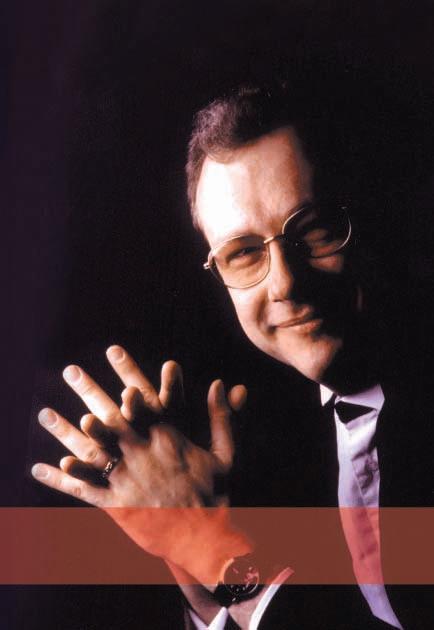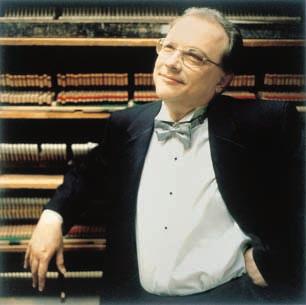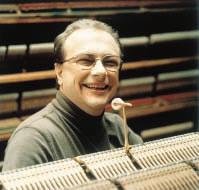
6.2.2004
香港大會堂音樂廳
Hong Kong City Hall Concert Hall
馬克﹣安德烈.哈梅林
鋼琴演奏會
Marc-André Hamelin
Piano Recital
演出長約1小時30分鐘,包括一節15分鐘中場休息
Running time: approximately 1 hour and 30 minutes, including a 15 minute interval
節目詳情
For programme details
Page 9 頁
為了讓大家對這次演出留下美好印象,請切記在節目開始前關掉手錶、無㵟電話及傳呼機的響鬧裝 置。會場內請勿擅自攝影、錄音或錄影,亦不可飲食和吸煙,多謝合作。
To make this performance a pleasant experience for the artists and other members of the audience, PLEASE switch off your alarm watches, MOBILE PHONES and PAGERS. Eating and drinking, unauthorised photography and audio or video recording are forbidden in the auditorium. Thank you for your co-operation.
馬克 - 安德烈.哈梅林
法裔加拿大鋼琴家馬克– 安德烈.哈梅 林於蒙特利爾出生,丹第音樂學院及 費城坦普爾大學肄業。對他影響深遠 的導師有依馮娜.胡伯特、哈維.域 丁以及羅素.沙曼。
哈梅林十三歲初次接觸查爾斯.艾菲 斯的音樂,開始對不囿於傳統的作曲 家產生興趣。他由蒙特利爾遷居費城 後,在當地的坦普爾大學取得音樂學 士及碩士學位。 1985 年,哈梅林奪得 卡內基音樂廳國際美洲音樂大賽冠 軍,從此晉身世界樂壇。
Marc-André Hamelin
French-Canadian pianist Marc-André Hamelin was born in Montreal and studied at the Vincent d’Indy School of Music and Temple University in Philadelphia. His principal teachers were Yvonne Hubert, Harvey Wedeen and Russell Sherman.
At the age of 13 he discovered the music of Charles Ives and became interested in the less conservative composers. Moving from Montreal to Philadelphia he earned his Bachelor and Master’s degrees in music from Temple University and came onto the world concert

哈梅林眾多不同種類的唱片曲目,正 好反映他對探索傳統及發掘冷門曲目 的旨趣。他所灌錄的三十六張唱片包 羅萬象,既有阿爾堪、伯恩斯坦、博 爾康、亨瑟特、科恩戈爾德以及約 瑟.馬克斯之協奏曲,也有阿爾堪獨 奏大碟(榮獲 1996 年加拿大朱諾獎), 以及演奏加多利、格林格(榮獲1997年 澳洲音樂景象大獎)、李斯特、雷格 爾、羅斯拉維特斯、雷治斯基、舒曼、 維拉.洛寶斯等作品的唱片;而史克 里亞賓及麥特拿奏鳴曲全集,以及《作 曲家-鋼琴家:從阿爾坎到哈梅林》則 為他分別奪得 1997 及 1998 年德國唱片 評論家大獎。哈梅林亦曾與馬克.艾 爾特指揮的伯明翰城市交響樂團合 作,灌錄布梭尼《C 大調鋼琴協奏曲, 作品39》,獲得各界讚賞。2000年,他 演繹的高道夫斯基《改編自蕭邦練習曲 的練習曲》贏得「留聲機」器樂大獎。
2001 年成為有史以來首位在洛杉磯舉 行的「留聲機」大獎頒獎典禮上演出的 古典樂手; 2002 年憑《作曲家-鋼琴 家:從阿爾坎到哈梅林》再度獲得格林 美提名。
scene when he won first prize in the 1985 Carnegie Hall International American Music Competition.
Marc-André Hamelin’s interest in exploring both traditional and little-known repertoire is reflected in his extensive discography. His 36 recordings include concertos by Alkan, Bernstein, Bolcom, Henselt, Korngold and Joseph Marx, as well as solo discs of Alkan (Canadian Juno Award 1996), Catoire, Grainger (Soundscapes Award 1997, Australia), Liszt, Reger, Roslavets, Rzewski, Schumann, Villa Lobos, the complete sonatas of both Medtner and Scriabin and The ComposerPianists: from Alkan to Hamelin , for which he received the prestigious Deutschen Schallplattenkritik Prize in 1997 and 1998. His recording of Busoni’s Piano Concerto in C major, Op 39 with the City of Birmingham Symphony Orchestra under Mark Elder received resounding critical acclaim, while the double album of Godowsky’s The Complete Studies on Chopin’s Études won the 2000 Gramophone Instrumental Award and a Grammy nomination.
In 2001 Hamelin was the only classical artist to play live at the Grammy Awards ceremony in Los Angeles and in 2002 he received another Grammy nomination for his recording The Composer-Pianists: from Alkan to Hamelin.
演後藝人談
歡迎節目後留步,與演奏家哈梅林 會面。
Meet-the-Artist (Post-Performance)
If you would like to meet Mr Hamelin, please stay behind in the auditorium after the performance.
封面設計 Cover Design © Acorn Design Ltd 封面照片 Cover Photograph©Malcolm Crowthers/Hyperion
節目
布梭尼改編巴赫
《夏康舞曲》(選自 D 小調小提琴變奏曲),
BWV 1004
李斯特改編舒伯特 《喪禮進行曲》
(選自《為鋼琴改編之進行曲》, S 426)
李斯特
《B-A-C-H 幻想曲及賦格曲》, S 529
-中場休息十五分鐘
史克里亞賓
第七奏鳴曲,作品 64(《白色彌撒曲》)
高道夫斯基 七首練習曲
(選自《改編自蕭邦練習曲的練習曲》)
第七首(改編自作品 10 第五首)
第十三首 ,只用左手演奏
(改編自作品 10 第六首)
第十八首(改編自作品 10 第八首
模仿作品 25 第二首)
第三十三首(改編自作品 25 第五首)
第四十四首 ,只用左手演奏
(改編自遺作練習曲第一首)
第四十五首
(改編自遺作練習曲第二首)
第一首(改編自作品 10 第一首)
Programme
Bach-Busoni
Chaconne from Partita No 2 in D minor for solo violin, BWV 1004
Schubert-Liszt
Trauermarsch – Grande Marche funèbre (from Märsche für das Pianoforte übertragen, S 426)
Franz Liszt
Fantasia and Fugue on the theme B-A-C-H, S 529
15 minute interval –
Alexander Scriabin
Sonata No 7, Op 64, Messe Blanche
Leopold Godowsky
Seven Studies from The Complete Studies on Chopin’s Études
No 7 (after Op 10, No 5)
No 13 for the left hand alone (after Op 10, No 6)
No 18 (after Op 10, No 8 –imitation of Op 25, No 2)
No 33 (after Op 25, No 5)
No 44 for the left hand alone (after Posthumous Étude No 1)
No 45 (after Posthumous Étude No 2)
No 1 (after Op 10, No 1)
拍掌
較長篇的樂章常分為不同長度的樂章部份。雖然 樂章與樂章之間有若干停頓,但觀眾毋須急於此 時報以掌聲;觀眾可待整首樂曲完結後,才開始 拍掌以表欣賞及支持。
Applause
Longer pieces of music are often divided into sections called movements. Between movements there is a pause in the music; however, the audience doesn’t usually applaud at this time. Instead, they save all their applause for the end of the entire piece.
《夏康舞曲》(選自 D 小調
小提琴變奏曲, BWV 1004)
布梭尼 (1866-1924)
改編巴赫 (1685-1750)
《夏康舞曲》寫於 1720 年代初。在樂曲 的第一段,巴赫刻意運用厚重的織 體,以小提琴的四根弦線,極力模仿 鍵盤樂器或樂團的效果;隨後的變奏 圍繞一組不斷重複的四小節和聲,加 以發展而成,節奏一段比一段緊湊密 集,讓小提琴發揮所長。
相較於小提琴,鋼琴能同時彈奏多個 樂音,將更多聲音置於十指之下。巴 赫原作織體較為疏落,而布梭尼的改 編版(寫於 1890 年代末)一方面利用鋼 琴的優點,將原作的和聲發揮得淋漓 盡致,另一方面也會偶爾天馬行空地 擴充原作,但始終以尊重巴赫原意為 依歸。
Chaconne from Partita No 2 in D minor for solo violin, BWV 1004
Johann Sebastian Bach (1685-1750) arranged by Ferruccio Busoni (1866-1924)
When Bach originally composed the opening of his Chaconne, probably sometime in the early 1720s, his intention was to try to suggest, as closely as was possible on the four strings of a violin, the denser texture of a work scored for keyboard or full orchestra. In the ensuing variations (built around a continually repeated implied four-bar harmonic pattern), he allowed the violin to be its virtuoso self, in a sequence of ever more rapid divisions.
Using the pianist’s capacity to fit many more notes under the hand, Ferruccio Busoni’s transcription for piano (dating from the late 1890s) realises much of the harmonic richness latent in Bach’s more sparsely scored original, as well as, occasionally, expanding imaginatively, but respectfully, on Bach’s conception.
《喪禮進行曲》(選自《為鋼琴
改編之進行曲》, S 426)
李斯特 (1811- 1886)
改編舒伯特 (1797-1828)
舒伯特的《喪禮進行曲》寫於 1826 年, 紀念不久前駕崩的沙皇亞歷山大一 世。可是,李斯特改編的並非舒伯特 的《喪禮進行曲》,而是他的四手聯彈 作品《六首大進行曲》(作品 40 ,
D819 ,約作於1825 年)的第五首降E 小 調進行曲,然後換上《喪禮進行曲》的 標題。
Trauermarsch – Grande Marche funèbre (from Märsche für das Pianoforte übertragen, S 426)
Franz Schubert (1797-1828) arranged by Franz Liszt (1811-1886)
Schubert composed his Grande Marche Funèbre in 1826, in memory of the recently deceased Tsar of Russia, Alexander I. It is not, however, the same work that Liszt transcribed here. Rather, the work Liszt chose, and gave the same title, was Schubert’s March No 5 in E flat minor from another set for piano 4-hands, the 6 Grand Marches, Op 40 (D 819), probably composed around 1825.
李斯特將舒伯特本來的四手聯彈原 作,改為只由一人演出,演奏難度極 高。此曲 1846 年於巴黎寫成,出版時 題獻給其友,鋼琴家蒂埃.德方丹; 也有說此曲本來是送給另一 朋友 西蒙.呂韋作為「獻禮」。銀 行家西蒙.呂韋是維也納人,舉止肅 穆,性格深沉,被友儕冠以「殯儀員」 的諢號,據說李斯特打算將此曲送給 他,算是幽默「獻禮」。
Liszt made his virtuoso transcription, in which he reworked Schubert’s 4-hand original for just 2-hands, in Paris in 1846, and dedicated it on publication to his friend, the pianist Mortier de Fontaine. There is also a suggestion that it was intended as an amusing “tribute” to one of Liszt’s other friends at the time, the Viennese banker Simon Löwy, who, because of his dour demeanour, was nicknamed “the undertaker”.
S 529
李斯特 (1811-1886)
《B-A-C-H 幻想曲及賦格曲》原定於 1855 年 9 月 26 日,由管風琴家亞歷山 大.維特伯格首演,為梅爾瑟堡大教 堂新管風琴的啟用典禮誌慶;但由於 樂曲未能如期完成,於是維特伯格 將演奏曲目改為另一首已準備好的 樂曲 李斯特另一傑作《再來,來 到這醫治的水泉》。
《B-A-C-H 幻想曲及賦格曲》終於在六 個月後完成,並於 1856 年 5 月 13 日首 演。德語習慣將「降 B 」稱為「B 」,將 「還原B」稱為「H」,而整首樂曲就圍繞 由「降 B-A-C- 還原 B」組成的短小主題 發展而成。
《B-A-C-H 幻想曲及賦格曲》即使用管 風琴演奏難度也極高,更遑論作曲家 自行改編的鋼琴版本了。莫舍萊斯 1859 年聽過李斯特親自以鋼琴演繹此 曲後,形容《B-A-C-H 幻想曲及賦格 曲》的結構精奇,而李斯特的演奏則 「精采絕倫」。
Fantasia and Fugue on the theme B-A-C-H, S 529
Franz Liszt (1811-1886)
This work was to have been first performed by the organist Alexander Winterberger at the inauguration of a new organ in Merseburg Cathedral on the 26 September 1855. It was not completed on time, however, and Winterberger substituted another work by Liszt, already in his repertoire, the great Fantasy on Ad nos ad salutarum.
The B-A-C-H fantasy was finally finished six months later, and first performed on 13 May 1856. It is based on a short theme whose notes spell out “BACH”, according to the German system of note naming: B flat-A-C-B natural.
A difficult work to play even on the organ, it is more challenging still in Liszt’s own arrangement for piano. Moschelles heard Liszt himself play it at the piano in 1859, describing it as “a piece full of dazzling combinations, and stupendously played”.
-中場休息十五分鐘 15 minute interval
第七奏鳴曲,作品 64
(《白色彌撒曲》)
史克里亞賓 (1872-1915)
史克里亞賓跟拉克曼尼諾夫在莫斯科 音樂學院份屬同窗,也同樣以鋼琴演 奏為業。史克里亞賓的鋼琴作品多不 勝數,最重要者為十首寫於 1892 至 1913 年間的鋼琴奏鳴曲。
雖然史克里亞賓常常親自演奏這些作 品,卻不願公開演奏第六奏鳴曲。有 人說,第六奏鳴曲需要寬闊的伸展 度,以史克里亞賓的一雙小手實在難 以應付;但作曲家本人則聲稱對這首 奏鳴曲另有顧慮,認為它「可怕、陰 暗、邪門」。為了袪除第六奏鳴曲的 「邪氣」,就寫了「燦爛、明淨、純潔」 的第七奏鳴曲,副題為《白色彌撒 曲》;兩年後寫的第九奏鳴曲,由於酷 似第七奏鳴曲,卻較陰沉,而被冠以 《黑色彌撒曲》的非正式綽號。
Sonata No 7, Op 64
Messe Blanche
Alexander Scriabin (1872-1915)
Scriabin was a classmate of Rachmaninov at the Moscow Conservatory, and like Rachmaninov went on to pursue a career as a concert pianist. His large output for the piano centres on ten sonatas, dating from 1892 to 1913.
Though he usually performed his own compositions, Scriabin avoided playing the Sixth Sonata in public. Some said that the wide stretches it required were beyond the grasp of his small hands. He himself claimed to have other misgivings about the piece, which he regarded as “nightmarish, murky, and unclean”. Partly to exorcise its “evil” influence, he composed this “radiant, pure, clean” Seventh Sonata, which he subtitled Messe Blanche (White Mass). It was to sprout another “dark” double, two years later, in the Ninth Sonata, unofficially dubbed “Black Mass”.
七首練習曲(選自《改編自 蕭邦練習曲的練習曲》)
高道夫斯基 (1870-1938)
高道夫斯基是自學成才的天才鋼琴 家 他曾宣稱五歲起,從未隨任何 老師上過一課。
1893年他在紐約寫作《改編自蕭邦練習 曲的練習曲》第一首時,年僅廿三歲。
其時高道夫斯基家中驟生慘變(其妻子 及小舅均死於一宗鐵路事故),為免自 己胡思亂想,他遂埋首研究蕭邦其中 一首練習曲,結果發展出一套嶄新指 法,對訓練左手特別有效。
Seven Studies from The Complete Studies on Chopin’s Études
Leopold
Godowsky (1870-1938)
A self-taught prodigy, Godowsky claimed to have had no lessons from any teacher at all after his fifth birthday.
He was only 23 when, in New York in 1893, he composed the first of his Studies on Chopin’s Études. In an attempt not to brood on a family tragedy (the death of his brother-in-law and his wife in a railway accident), he threw himself into a close examination of one of Chopin’s studies, developing a new method of fingering which he found especially freed up the left hand.
高道夫斯基認為,左手是「掌握鍵盤整 個低音部份,可以讓演奏者更輕鬆、 更富彈性地奏出更豐富、更圓潤的聲 音,不論質與量都勝過右手」,而他隨 後創作的練習曲也有好幾首只用左手 彈奏。高道夫斯基 1914 年完成整套改 編練習曲,前後合共五十三首。
全用黑鍵彈奏的第七首「活板」,將蕭 邦原作的左右手角色對調。
第十三首則將蕭邦本來讓兩手演奏的 原作重新編排,改為只用左手,因此 馬克 安德烈.哈梅林也說這首是「最 難應付的」。
哈梅林將第十八首「堅定的快板」形容 為「堂皇壯麗的作品」,也是將蕭邦原 作的左右手角色對調。
至於第三十三首「不太快的快板」, 哈梅林評論道:「大概除高道夫斯基, 不會有人為蕭邦原作披上如此瑰麗的 外衣了︙︙儘管曲中有極複雜的雙音 和副旋律,它毋疑是高道夫斯基最傑 出的改編之一。」
第四十四首「有動力的快板」也是只由 左手彈奏,既是最接近蕭邦原作的一 首,也是這套曲集况比較容易應付的 一首。
第四十五首「小快板」令人「歎為觀 止」,運用蕭邦原作的開端為主題,寫 成「四個瑰麗異常、既美妙又錯綜複雜 的變奏」,而且「在末段,絢麗的副旋 律則在整個織體之上翱翔」。
第一首「莊嚴的快板」也是由左手彈奏 本來屬於右手的音型,游走於鍵盤之 上。哈梅林形容這首是「十分華麗的改 編,與氣勢磅礡的原作旗鼓相當,甚 至更加洶湧澎湃。」
所有樂曲介紹:格雷姆.史堅拿 中譯:鄭曉彤
Godowsky pointed out that the left hand, “commanding the lower half of the keyboard”, allows the player to produce with less effort and more elasticity a fuller and mellower tone, superior in quantity and quality to that of the right hand”, and several of the ensuing Studies were composed for it alone. By 1914, when his project reached its conclusion, Godowsky had completed 53 new studies on Chopin’s original studies.
The No 7 is a Vivace on the black keys and reverses the role that Chopin originally gave to the left and right hands.
In No 13, a reworking of all of the elements of Chopin’s 2-hand original for the left hand alone makes this, in Marc-André Hamelin’s opinion, “one of the most intractable” of all the studies. In No 18 (Allegro risoluto), which Hamelin calls “a grandly imposing creation”, Godowsky again reverses the role of the hands.
In the case of No 33 ( Allegro ma non troppo ), Hamelin remarks: “Clothing Chopin’s creations in such sumptuous textures would be unusual for any other transcriber ... this transcription is one of his loveliest, despite the multiplicity of double-notes and counter-melodies”.
No 44 ( Allegro con moto ), again for left hand alone, is perhaps closest of this selection to Chopin’s original, and also one of the most accessible of Godowsky’s treatments.
No 45 (Allegretto) is “a true marvel”. Chopin’s opening is the subject of “four hyperflorid, beautifully complex variations ... in the last section, a gorgeous counter-melody soars above the main music”.
No 1 (Allegro maestoso) now involves the left hand in the sweeping figurations that Chopin reserved for the right hand. Hamelin remarks: “A truly grand setting that matches the majestic sweep of its model, although rendering it somewhat more turbulent”.
All programme notes by Graeme Skinner

馬克 安德烈.哈梅林曾被《紐約時報》形容 為「以異常精確與鎮靜的方式,演奏近乎無 法演奏的歌曲,如掀起一個又一個的音樂 漩渦」。儘管他不以演奏「當代」音樂稱著, 卻能掌握那些十九世紀末不被列入任何 類別的晦澀樂曲,展現這些曲目的最大 深度。
不錯,他確能演奏貝多芬、蕭邦以及莫扎 特等曲目,但給他罕見的,如艾菲斯、阿 爾堪或是高道夫斯基的作品,他也一樣應 付自如。
他在香港演奏的是巴赫,卻是由布梭尼改 編的巴赫,也有蕭邦,卻是由高道夫斯基 改編的蕭邦,還有舒伯特,卻是由李斯特 改編的舒伯特。何故如此?
「啊!因為那些都是極佳的改編曲目。布梭尼 的改編絕對是大師級,高道夫斯基則將蕭邦 原版的練習曲改成演奏曲目。不錯,我喜歡 演奏原裝的舒伯特《喪禮進行曲》,但我沒有 四隻手。」
文:哈里.羅爾尼克
哈梅林在演奏史克里亞賓的《第七奏鳴曲》時 更是寧靜得出了神,這曲目被稱為「白色彌撒 曲」,亦可能是這玄秘作曲家作品中最玄秘的 樂曲。哈梅林也提醒觀眾:「不要以這種角 度來聽︙︙試試把這想像成一個不可思議 的旅程。史克里亞賓就是這麼一個不可思 議的破天荒作曲家。除去那些只得其形的 模仿者,他的表現手法是獨一無二的。
「我得告訴你,我並不強迫人們聽這些音 樂。但我確切相信,樂迷,尤甚是年輕的 樂迷,已經聽膩了貝多芬的《熱情奏鳴曲》 或穆索爾斯基的《圖畫展覽會》。
「取而代之,樂迷應該想像自己步入一個佈 滿小店的小鎮,其中一家古董店的陳列架 上都是寶物,和釘裝得美侖美奐的書冊 等。為何不把它們帶回家慢慢享受?我演 奏一些樂迷未聽過的作品,所做的正是讓 他們把最好的帶回家去。」
全文原載於《閱藝2003》
